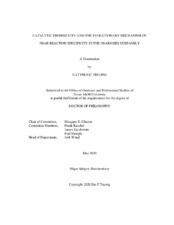| dc.description.abstract | Catalytic promiscuity is the coincidental ability for an enzyme to catalyze nonbiological reactions in the same active site as the native biological reaction. Several lines of evidence show that catalytic promiscuity plays an important role in the evolution of new enzyme functions. Studying catalytic promiscuity can help identify structural features that predispose an enzyme to evolve new functions. This dissertation studies the mechanistic basis of catalytic promiscuity in the evolution of N-succinylamino acid racemase (NSAR) activity in the NSAR/o-succinylbenzoate synthase (NSAR/OSBS) subfamily. The NSAR/OSBS subfamily is a branch of the OSBS family, which belongs to the mechanistically diverse enolase superfamily. We identified a conserved, second-shell residue R266 in all the NSAR/OSBS enzymes while the homologous position is usually hydrophobic in other nonpromiscuous OSBS subfamilies. We found that the R266 residue is an important NSAR reaction specificity determinant because the R266Q mutation in Amycolatopsis NSAR/OSBS enzyme profoundly reduces NSAR activity while having a moderate effect on OSBS activity. Mechanistic investigation by hydrogen-deuterium exchange showed that R266 modulates the reactivity of the catalytic base K263, but not the other catalytic base K163. The crystal structure of Amycolatopsis NSAR/OSBS R266Q mutant shows that K263 adopts a different conformation, so it is not positioned correctly to act as a general acid/base for catalysis. Further kinetic and mechanistic studies of the R266Q mutation in other NSAR/OSBS members showed that R266 is also important for NSAR activity. However, the specific phenotypic effects of the R266Q mutation are masked by the sequence and structural contexts in which the mutation occurs (that is, epistatic constraints), making it harder to fully understand the roles of R266 in the NSAR/OSBS subfamily. Up to date, R266 is the first residue that was identified in the NSAR/OSBS enzymes to be pre-adaptive and vital for NSAR activity, and such identification is essential to understand the evolution of NSAR activity in the NSAR/OSBS subfamily. This finding is significant because it can help us understand the reaction specificity determinants in other enzymes. For example, mutating the homologous lysine to a glutamine in members of the dipeptide epimerase family also has a deleterious effect on the activity, further supporting the universal importance of a positively charged amino acid at position 266 for the epimerase/racemase activity in the enolase superfamily. This dissertation provides the mechanistic basis of determining epimerase/racemase reaction specificity in enzymes and can be ultimately used as a predictive tool for functional annotations, the development of protein engineering, and the improvement of protein design methods. | en |


